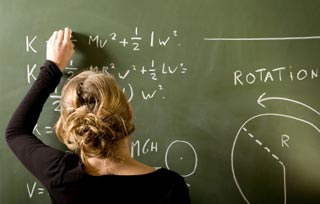Culture, not biology, underpins math gender gap
For more than a century, the notion that females are innately less capable than males at doing mathematics, especially at the highest levels, has persisted in even the loftiest circles.

This was one of the primary reasons posited in 2005 by Lawrence Summers, then president of Harvard University and current economic adviser to President Barack Obama, for the extreme scarcity of tenured women math professors in top-ranked research universities in the U.S.
Now, however, in an analysis of contemporary data published today (June 1) in the Proceedings of the National Academy of Sciences, researchers from the University of Wisconsin–Madison report that the primary cause for the gender disparity in math performance at all levels is culture, not biology.
“It’s not an innate difference in math ability between males and females,” says Janet Mertz, a UW–Madison professor of oncology and one of the authors of the article that analyzes and summarizes recent data on math performance at all levels in the United States and internationally. “There are countries where the gender disparity in math performance doesn’t exist at either the average or gifted level. These tend to be the same countries that have the greatest gender equality.”
In the new PNAS report, Mertz and UW–Madison professor of psychology Janet Hyde set out to answer three key questions: Do gender differences in math performance exist in the general population? Do gender differences exist among the mathematically talented? Do females exist who possess profound mathematical talent? The answers, according to the Wisconsin researchers, are no, no and yes.
Using disparate but complimentary sources of data — ranging from state standardized tests used to assess student performance under the No Child Left Behind Act to the transnational Programme for International Student Assessment to the elite International Mathematical Olympiad — the Wisconsin researchers document a pattern of performance that strongly suggests that the root of gender disparity in math can be pegged to changeable sociocultural factors. Such factors either discourage or encourage girls and young women in the pursuit of the skills required to master the mathematical sciences.
In the United States, girls at all grade levels now perform on a par with boys on the standardized mathematics tests required of all students. Moreover, U.S. girls are now taking calculus in high school at the same rate as boys, and the percentage of U.S. doctorates in the mathematical sciences awarded to women has climbed to 30 percent in the 21st century, up from a nadir of 5 percent in the 1950s.
Among the mathematically gifted, there are still more boys being identified than girls in the U.S., but the gap is narrowing and will likely continue to close as broader issues of gender inequity are addressed in American society. “On average, girls have reached parity with boys in the United States and some other countries, and the gender gap at the high end is closing,” says Hyde.
In their report, Mertz and Hyde challenge the validity of the greater male variability hypothesis, invoked by Summers, which says that males are biologically more variable than females in math ability, thus accounting for why more males are found with very high math skills.
Contradicting this assertion, the Wisconsin researchers show that girls’ math scores are as variable as boys’ in some countries and among some ethnic groups in the U.S., with as many girls as boys scoring above the 99th percentile in some cultures. Thus, greater male variability in math performance is not a ubiquitous phenomenon. Rather, Hyde and Mertz report that the ratio of girls to boys excelling in math correlates quite well with measures of a country’s gender equity.
“If you provide females with more educational opportunities and more job opportunities in fields that require advanced knowledge of math, you’re going to find more women learning and performing very well in mathematics,” says Mertz.
“U.S. culture instills in students the belief that math talent is innate; if one is not naturally good at math, there is little one can do to become good at it,” Mertz adds. “In some other countries, people more highly value mathematics and view math performance as being largely related to effort.”
The difference in attitude is likely a major reason the median scores of girls as well as boys in some East Asian countries are higher than the top 10 percent of both boys and girls in the U.S. on standardized transnational math tests. Children of immigrants from these countries, girls as well as boys, tend to excel in math even while being raised and educated in the U.S.
While the gender gap in math performance seems to be narrowing, Hyde and Mertz caution that the United States may fall further behind other nations in math performance as tests mandated by No Child Left Behind include almost no questions requiring complex problem-solving.
“This neglect of problem-solving skills could place U.S. students at a disadvantage compared with their peers in countries where teaching and tests emphasize more challenging content,” write Hyde and Mertz.
Finally, the Wisconsin researchers note that the future of the U.S. economy depends upon American society doing a better job of identifying and nurturing mathematically talented youth, regardless of gender, race or ethnicity: “The United States could do a lot better,” says Hyde.




